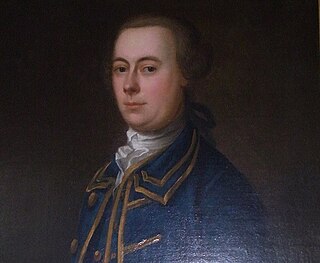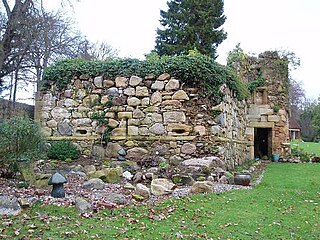
Sir Robert Munro of Foulis, 6th Baronet was a soldier-politician whose life followed an 18th-century pattern. He fought in support of the Revolution Settlement and the House of Hanover, and their opposition to all attempts by the Jacobites to restore the House of Stuart either by force of arms or by political intrigue. He was killed at the Battle of Falkirk Muir in 1746.

Sir Harry Munro, 7th Baronet was 25th Baron and the 28th chief of the Clan Munro. He was a Scottish soldier and politician. He was loyal to the Hanoverian dynasty and served as a captain in Loudon's Highlanders Regiment 1745–48.

Newmore Castle is situated just north of the town of Alness in Ross and Cromarty, Highland, Scotland.
Sir Robert Munro, 5th Baronet of Foulis was also 23rd Baron and 26th chief of the Clan Munro. He became blind and was known as the Blind Baron.
Sir George Munro of Culcairn was a Scottish soldier of the 18th century from Ross-shire, Scotland. He commanded the 3rd Independent Highland Company from 1714 to 1716, fought at the Battle of Glen Shiel in 1719, led the 6th Company in formation of the "Black Watch" in 1725, the 8th Company of Black Watch when it was regimented in 1739 and again commanded an Independent Highland Company in 1745–46. He was shot in error in 1746.

Sir George Munro, 1st of Newmore (1602–1693) was a 17th-century Scottish soldier and member of parliament from the Clan Munro, Ross-shire, Scotland. He was seated at Newmore Castle. Between 1629 and 1634 Munro held command in the Swedish army during the Thirty Years' War, and from 1642 in the Scottish Covenanter army during the Irish Confederate Wars before changing his allegiance to the Royalist cause of Charles I in 1648 during the Scottish Civil War and Irish Confederate Wars.
Robert Mor Munro, 15th Baron of Foulis, and 18th chief of the Clan Munro was a 16th-century Scottish chief. He was known as Robert Mor on account of his large stature. He was the eldest son of Robert Munro, 14th Baron of Foulis. Although this Robert Munro is traditionally 15th Baron and 18th overall chief of the clan, he is only the 8th Munro chief that can be proved by contemporary evidence.

There have been three baronetcies created for persons with the surname Munro, one in the Baronetage of Nova Scotia and two in the Baronetage of the United Kingdom.
Sir Robert Munro, 3rd Baronet of Foulis, 21st Baron and 24th chief of the Clan Munro was a 17th-century Scottish soldier and politician.

The chiefs of the Scottish highland Clan Munro, the Munros of Foulis, are according to tradition, descended from a Donald Munro of Foulis who died in 1039. However their descent can only be proved by contemporary evidence back to a Robert de Munro who died in 1369.
George Munro of Foulis is traditionally the 10th Baron and 13th successive chief of the Clan Munro. However, he is only the third successive chief of the clan who can be proved by contemporary evidence. He was the eldest son of Hugh Munro, 9th Baron of Foulis and was seated at Foulis Castle.
Sir Hector Munro, 1st Baronet of Foulis was a Scottish soldier, noble and clan chief of the highland Clan Munro. He is also by tradition the 19th Baron and 22nd overall chief of the clan. He is however the 12th chief of the Clan Munro who can be proved by contemporary evidence.
Hector Munro, 13th Baron of Foulis was a Scottish clan chief of the highland Clan Munro in Rosshire. He is by tradition 13th Baron of Foulis and 16th overall chief of the clan. However, he is only the 6th chief of the Clan Munro who can be proved by contemporary evidence.

Sir Charles Munro, 9th Baronet of Foulis was a Scottish Baronet and soldier. He was also chief of the Highland Clan Munro.

The Munros of Obsdale were a Scottish family and a cadet branch of the Clan Munro, a Highland Scottish clan. Their base was at Obsdale House, situated just north of the town of Alness in the Scottish Highlands. Some of the members of the Munro of Obsdale family were amongst the most distinguished Scottish military officers of the 17th century.

Clan Munro is a Highland Scottish clan. Historically the clan was based in Easter Ross in the Scottish Highlands. Traditional origins of the clan give its founder as Donald Munro who came from the north of Ireland and settled in Scotland in the eleventh century, though its true founder may have lived much later. It is also a strong tradition that the Munro chiefs supported Robert the Bruce during the Wars of Scottish Independence. The first proven clan chief on record however is Robert de Munro who died in 1369; his father is mentioned but not named in a number of charters. The clan chiefs originally held land principally at Findon on the Black Isle but exchanged it in 1350 for Estirfowlys. Robert's son Hugh who died in 1425 was the first of the family to be styled "of Foulis", despite which clan genealogies describe him as 9th baron.

The Skirmish of Alness was a conflict that took place in October 1715 in Alness, in the county of Ross in the Scottish Highlands. It was part of the Jacobite rising of 1715 and pitted Highlanders loyal to the British-Hanoverian Government of George I of Great Britain against Highlanders loyal to the Jacobite House of Stuart.
The Munros of Culcairn were a minor noble Scottish family and a branch of the ancient Clan Munro, a Scottish clan of the Scottish Highlands. Their seat was at Culcairn which is on the east side of Allt Graad/River Glass in the parish of Kiltearn.
The Munros of Culrain were a minor noble Scottish family and a cadet branch of the ancient Clan Munro, a Scottish clan of the Scottish Highlands. They were seated at Culrain which is in the south of the county of Sutherland, but to the north of the main Munro clan lands in Kiltearn, Easter Ross.
The Munros of Kiltearn were a minor noble Scottish family and a branch of the ancient Clan Munro, a Scottish clan of the Scottish Highlands.They were seated at Kiltearn House which was a manor house that shared the same name of the parish it was situated in, Kiltearn. In Scottish Gaelic the Munros of Kiltearn are known as the Sliochd-Alastair-Mhic-Uistean. The most famous member of the Munro of Kiltearn family was Donald Monro, High Dean of the Isles.








